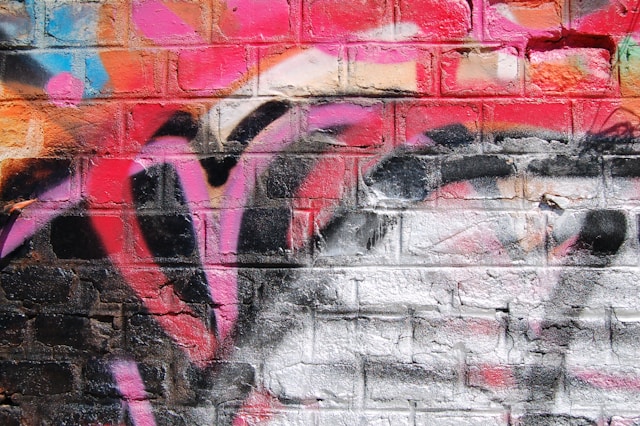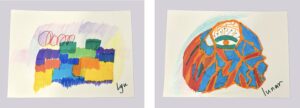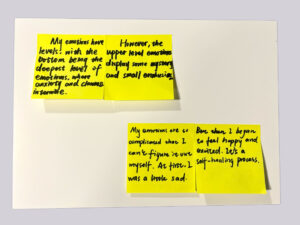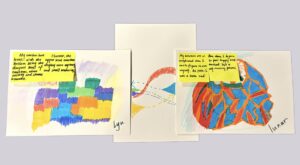Graffiti Journeys: Where Emotions Speak

Do you frequently struggle to put your feelings into words
and no place to vent your emotions?
Do you find it difficult to capture the emotions of the moment?
「INTRODUCTIONE」:Emotions are sometimes Regarded as abstract and hard to visualize. However, As the saying goes, “Art is a voice that refuses to be silenced.” When art and emotions meet, what kind of sparks will ignite? 💥
Graffiti is often seen as a form of antisocial behavior in the city, but studies in art therapy suggest that it can serve as a powerful medium for self-expression and emotional release. —— 《Artefact Magazine》
With the help of this toolkit, let’s explore emotions through graffiti! 🔛🎨✨
⬇️ ⬇️
Material preparation
Don’t worry about that! Necessary materials will be prepared and these are the materials that are needed.🎊🎊🎊
-
Several sheets of A4 paper
-
Color brushes
-
Sticky notes
Guidance video (optional)
For accessibility reasons, the steps are also guided by this video for someone who can’t read the instructions. This video presents a more straightforward explanation of the toolkit.
If you don’t have such obstacles, please skip this part and continue to read the steps below!
How to create emotional graffiti?
Step1: Think about your current mood
Please calm down, take deep breaths to stay concentrated, and feel your current mood, whether it is joy, stilly, irritability, sadness, or a mixture of emotions.
You can improve your thinking by answering the following questions:
-
Word Association:
If you need to use three words to describe your mood, what words do you think they are?
-
Image Association:
If you need to draw an image to express your mood, what is the first reaction that comes to your mind?
Step2: Create your emotional graffiti
You need to choose colors, lines or patterns to match your emotions, and engage in creating your own graffiti as a medium for emotional expression.
❗️Important reminder❗️ Don’t worry about whether it looks good! !
Any shape and color is fine, as long as you think your graffiti can express your current mood.

Emotional graffiti example
「color guidance board」👇👇
Here is the emotional color guidance, which can help create your Graffiti.
✨ Important Tips✨ You need to know that with the same color, darker colors express stronger emotions, while lighter colors express weaker emotions.
-
Red: passion, energy, anger, alertness
-
Blue: tranquility, calmness, sadness, trust
-
Yellow: happiness, vitality, warmth, anxiety
-
Green: balance, relaxation, nature, safety
-
Purple: mystery, calmness, loneliness, sadness
-
Brown: heavy, monotonous, tired, boring
Step3: Record your emotions
On the sticky note, please record the emotions that draw your creative expression for graffiti. They should be no more than two sentences.
Here are some angles you may choose to describe:
-
The main components of your emotions
-
Your fluctuations in emotions
-
The levels of your different emotions
-
( Or express it in a more personalized way )

Emotions sticky note example
Step4: Choose artistic elements
Observe and explore the person’s graffiti sitting next to you to reflect on the emotions behind each color and pattern.
This is a process of realizing your own uniqueness. By observing the creations of others, you will deeply realize that even in the same time and environment, different individuals still express emotions in different ways.
Step5: Connect emotional graffiti (optional)
If you are interested, you can connect your graffiti with another person to create a dynamic collective artistic expression.
You can use lines or other methods to show the similarities or differences between your work and others.

Emotional graffiti connection example
Step6: Share your feelings (optional)
If you have the time and wish to discuss the creative process and share your feelings on color and line selection, please do so with others. You can also publish your work through social media to share your thoughts with more people.
Here are some questions to help guide your reflection:
-
How does this piece reflect your current emotions?
-
Did you feel anything different during the graffiti process than you did before?
-
What was your inner state like when you created these colors and patterns?
Congratulations!!🥳
you’ve finished it
Graffiti can help us get along with our emotions better. In daily life, whenever you feel that your emotions are difficult to calm down, you can pick up a colored pen as you like, using colors to bring peace and comfort to your heart.
「Possible links between graffiti and the creator’s personality」:
1. Color selection and matching
Bright colors: People who like rich colors are usually willing to express themselves, but sometimes they may be a little impulsive.
Randomly mixed colors: Showing unrestrained creativity, such creators may have an adventurous personality.
2. Shape style and arrangement
Regular symmetrical patterns: Usually reflect a rigorous and order-seeking personality.
Abstract and free patterns: Open-minded, sometimes a little rebellious.
3. Space distribution and utilization
The large area covering the picture: Extroverted personality, eager to gain more presence.
Significant partial blank space: Focus on thinking, or reflect a sense of incompleteness.
「Further exploration」: Emotional graffiti is one of the approaches of art therapy. If you’re interested in exploring more art therapy practices, visit the website below for additional resources.
https://www.alternativetomeds.com/blog/art-therapy-ideas/
If you have any suggestions or thoughts, feel free to contact me by email. I’d love to hear from you!
My Email: Jiayinglyu01@163.com
(Red and white painted wall © 2016 by Chris Barbalis is licensed under CC BY-SA 4.0 )
(Emotional graffiti guidance video © 2024 by Jiaying Lyu is licensed under CC BY-SA 4.0 )
(Emotional graffiti example © 2024 by Jiaying Lyu is licensed under CC BY-SA 4.0 )
(Emotions sticky note example © 2024 by Jiaying Lyu is licensed under CC BY-SA 4.0 )
(Emotional graffiti connection example © 2024 by Jiaying Lyu is licensed under CC BY-SA 4.0 )


